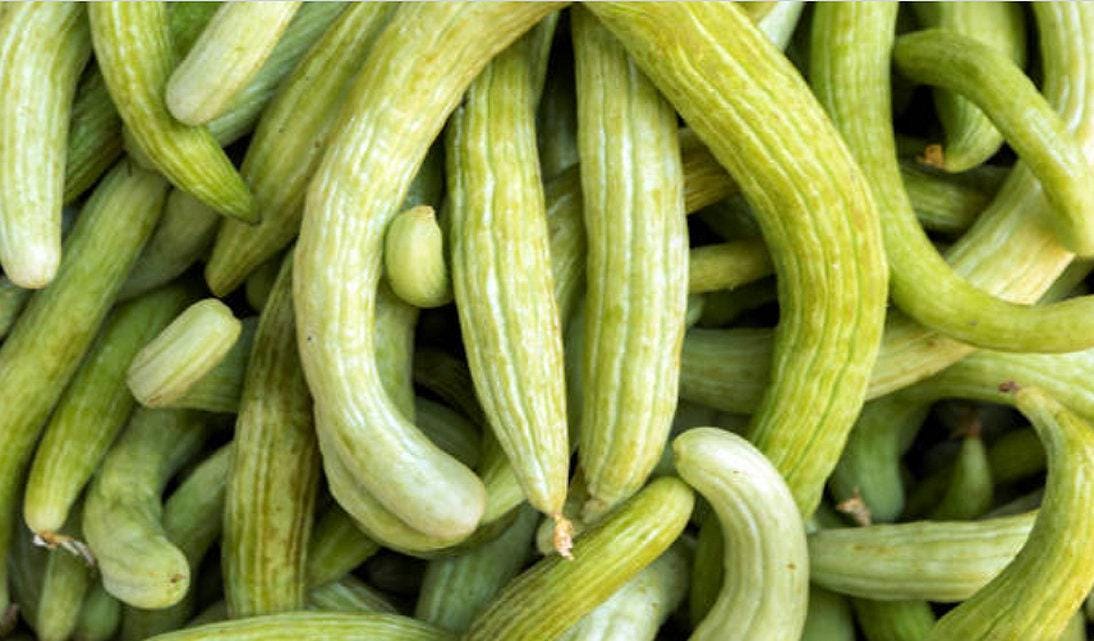The Armenian Cucumber (Cucumis melo var. flexuosus), also known as snake melon, is a unique and versatile heirloom variety that has been cultivated since the 1400s. Originating in western Asia, this frost-tender annual vine produces long, slender, and heavily ribbed fruits that are light green, spineless, and have a thin skin that does not require peeling. Despite being botanically classified as a muskmelon, Armenian cucumbers look and taste just like a cucumber, offering a crisp, mild, and sweet flavor that is burpless and ideal for fresh eating.
One of the standout features of the Armenian Cucumber is its exceptional heat tolerance, making it a perfect choice for gardeners in warmer climates. This variety thrives even in high temperatures, allowing it to be planted as late as the beginning of July in low desert regions. The vines can grow to an impressive 6-9 feet long and perform best when trellised, which helps produce straight fruits and saves garden space.
Native to: Armenia and Turkey, this cucumber is also believed to have origins in India, where it flourishes in mild to warm climates. The fruit can grow to remarkable lengths, sometimes earning it the name "The Snake Melon." When ripe, the fruits may take on a yellow hue and emit a subtle aroma similar to cantaloupe. Harvesting the fruits young ensures the best flavor and texture.
Common Names: Armenian Cucumber, Snake Melon, Serpent Cucumber, Yard-Long Cucumber
Latin Name: Cucumis melo var. flexuosus
Type: Vegetable
Life Cycle: Annual
USDA Zones: 4 - 11
Stratification: Not required
Germination Ease: Moderate
Sunlight: Full Sun
Moisture: Prefers consistently moist, well-drained soil
Soil: Rich, well-drained soil with a pH between 6.0 and 7.5
Height: Vines grow 6-9 feet long
Spread: 2-3 feet
Color: Light green, heavily ribbed, spineless fruits
Bloom Season: N/A (grown for fruits, not flowers)
Companion Plants: Suitable companions include beans, corn, and radishes.
Potential Toxicity: Non-toxic to humans and pets
Climate Adaptability: Highly adaptable to warm climates; thrives in high temperatures and performs well in low desert regions.
~ Sowing ~
When to Start Inside: Not typically recommended, as Armenian Cucumbers prefer direct sowing outdoors.
When to Start Outside: Direct sow seeds 14 days after the last frost, once the soil has warmed.
Sowing Instructions: Sow seeds 1/2 inch deep in well-drained soil.
Planting Depth: Sow seeds 1/2 inch deep.
Watering: Keep the soil consistently moist but not waterlogged. Armenian Cucumbers require regular watering, especially during dry periods.
Light and Temperature: Prefers full sun and warm temperatures, ideally between 75-85°F (24-29°C).
Germination: Seeds typically germinate in 7-14 days under optimal conditions.
~ Transplanting Seedlings Outdoors ~
Timing: Direct sowing is preferred, but if started indoors, transplant seedlings after the danger of frost has passed and when they have developed at least two sets of true leaves.
Location: Choose a sunny location with well-drained soil.
Spacing: Space plants 12-18 inches apart to allow for adequate air circulation and growth.
Transplanting: Handle seedlings carefully to avoid disturbing their roots. Water well after transplanting to help establish the plants.
~ Growing ~
Watering: Water regularly to maintain consistent soil moisture. Armenian Cucumbers thrive in warm, moist conditions but are also highly tolerant of heat.
Fertilizing: Apply a balanced fertilizer or compost at planting time and again as the plants begin to flower.
Pest and Disease Management: Armenian Cucumbers are generally disease-resistant but may attract pests like cucumber beetles or aphids. Monitor plants regularly and use organic pest control methods if necessary.
Maintenance: Trellising the vines can help produce straighter fruits and save garden space. Harvest fruits when they are young for the best flavor and texture.
~ Harvesting ~
When to Harvest: Harvest when the fruits are 12-18 inches long, typically around 68 days after sowing.
How to Harvest: Use a sharp knife or garden shears to cut the fruit from the vine, leaving a small portion of the stem attached.
Drying and Storing: Armenian Cucumbers are best used fresh. Store harvested fruits in the refrigerator for up to a week.
~ Seed Saving ~
Allow a few fruits to fully ripen and turn yellow on the vine. Scoop out the seeds, rinse, and dry them thoroughly before storing in a cool, dry place for future planting.
~ Additional Information ~
Forage for Pollinators: Armenian Cucumbers produce flowers that attract bees and other pollinators, aiding in fruit set.
Origin: Native to Armenia and Turkey, with historical cultivation in India, this cucumber has a rich history of use across cultures.
Nomenclature: The variety name "flexuosus" refers to the plant's flexible, winding growth habit, while "Cucumis melo" indicates its botanical classification as a muskmelon.
History: Cultivated since the 1400s in western Asia, Armenian Cucumbers have long been valued for their heat tolerance, productivity, and unique flavor. Despite being classified as a muskmelon, this fruit is commonly used and enjoyed as a cucumber.
Potential Toxicity: Non-toxic and safe for consumption by humans and pets.
Climate Adaptability: Armenian Cucumbers are highly adaptable to warm climates and are particularly well-suited to areas with hot summers.



















